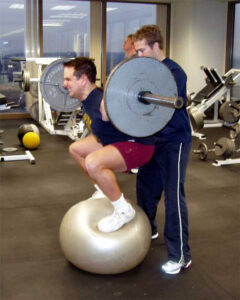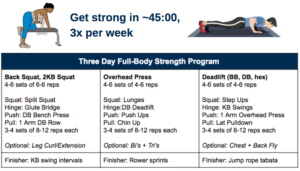You know that guy or girl who you see in the gym nearly every day, doing pretty much the same thing every workout? Or the person jumping around on a BOSU ball, doing different tricks every time?
They’re both making one fatal fitness mistake: failing to follow a progressive training program.
Going into the gym and doing the same thing every workout (3×10 bench at 135-lbs) will never get you anywhere because once your body adapts to the challenge of 10 reps at 135, there’s no stimulus to change. You’re wasting your time and energy while getting no stronger.
Doing something completely different in each workout is a mistake because your nervous system (CNS) never gets a chance to adapt and master the movements you’re doing. Without CNS adaptation, you’ll never become good enough at an exercise to fully challenge your muscles and joints by adding resistance. In essence, you’ll remain a beginner at everything, like someone who picks up a new instrument every week instead of focusing on piano or guitar for long enough to play scales and songs.

How can you avoid these progress-killing workout mistakes? By following a structured, progressive training program.
The fundamental principles that drive progress toward better fitness (strength, endurance, and lean muscle growth, aka “toning”) are neural adaptation and progressive overload.
We addressed neural adaptation above – you have to give your nervous system enough time (reps) to learn and master movements. This creates a stronger mind-muscle connection, allowing your brain to tell your muscles to fire faster and more efficiently during your workouts.
Progressive overload means systematically increasing the challenge from workout to workout. This can be done by adding sets and reps, increasing the amount of weight you lift, decreasing rest periods so you do more work in less time, or picking harder versions of exercises once you’re ready to progress.
In the gym, a training program provides structure and progresses you in some way toward your fitness goal – whether that’s getting your first pull up, hitting a new max back squat, or training for a 10K race. A training program is a roadmap from where you are now to where you want your fitness to be three to six months or a year from now.⠀
Without following a program, you’re just throwing darts at a board to see what sticks. Random workouts lead to random results, if any. That’s why people who “wing it” wind up spinning their wheels, just like that guy or girl at your gym who’s constantly bouncing around on BOSU balls without really getting any more fit.
Following a structured training program doesn’t mean your workouts should be so rigid that they become unenjoyable. You can have fun with your fitness. Follow your program, then throw in exercises you enjoy. If you love training your arms, end your workout with a bunch of bicep curls.
I structure most of my athlete’s training programs this way – starting with progressive, strength-focused exercises and ending with a fun “finisher” that gets them sweaty and ends the session on a high note. Following a program first, then ending with something fun is kind of like eating your veggies so you get to enjoy dessert. You’ll get better results from the program than you would from doing a bunch of random exercises while having fun in the process.
Here’s how you can build your own program so you actually progress and get stronger, faster, fitter, and more badass:
1. Decide your goal – pick one thing to focus on!
Do you want to get a pull up, strengthen your legs, or build lean muscle? Each goal requires a different approach.
Getting your first pull up means working on core strength, grip strength, shoulder stability, and pulling power. You’ll want to spend a lot of time working on hollow holds, glute bridges, planks, hanging from a pull up bar, and strengthening your shoulders and back.
Strength training is best done with heavy weights with low to moderate reps (3-5 or 8 reps per set). You’ll need to lift progressively heavier weights and add volume with exercises that isolate the muscles you’re trying to strengthen.
Building lean muscle requires “time under tension,” meaning you’ll work in a different rep range (8-12 reps with heavy weights and 10-20 reps with moderate weights).
I tell you this not to overwhelm you with information, but to emphasize that every unique goal requires a unique approach. That means you should pick one very specific thing to focus on. It doesn’t mean you can’t get a pull up while getting stronger legs or building bigger biceps, but those secondary goals should take a back seat for a while.
2. Decide how often you can commit to training (even when life gets crazy)
There are no bonus points for building a 7-day per week training plan if you can only realistically go to the gym 2-3 days per week. In fact, two or three days of resistance training is what I recommend for most of the people I work with because they’re busy and have interests outside the gym, like skiing. Too much training would be overwhelming and interfere with them having fun on the slopes (which is way more important in the grand scheme of things).
3. Include these elements – always: main strength movement and full-body exercises
Okay, now that you’ve established your goals and decided how often you can commit to training, figure out the main strength movements that will support your goals. Focus first on full-body, compound strength exercises that involve many muscles. You can add necessary isolation exercises in the next step if they’ll help you toward your goal.
These compound exercises include: squats; lunges; hip hinges like deadlifts; upper body pushes and presses; and upper body pulling movements like chin ups, pull ups, and rows.
Generally, you’ll want to focus on one heavy movement at the start of your workout. As you move to the next exercise or set of exercises, you’ll work in higher rep ranges with slightly lighter weights. The tail end of your workout is the time and place for high-rep sets.
4. Include these elements – optional: accessory lifts, finishers
“Accessory” lifts are exercises that support your main strength exercises. For instance, a leg curl or leg extension machine helps to isolate your hamstrings and thighs/quads (respectively) to assist with your squat.
Accessory lifts are also important in bodybuilding programs, which often involve 4-5 or more exercises for the same muscle group to stimulate muscle growth. If that’s your goal, you’ll want to include more accessory work, like direct arm work, calf raises, chest/back flys, etc.
Finally, finishers are aptly named because they finish off workouts with a heart-pumping, sweat-dripping, high-intensity effort. Keep finishers short and intense; too long and you won’t be able to sustain a fast pace, defeating the purpose of the finisher.
One of my favorite finishers is a kettlebell swing tabata: eight rounds of twenty seconds of swings paired with only eight seconds of rest. This takes all of four minutes, but will definitely leave you feeling worked.
Other great ideas for finishers:
- EMOM – “every minute on the minute” – Complete a given number of reps, rest in time remaining.
- AMRAP – “as many reps/rounds as possible” – Set a timer between 5-10 or 12 minutes and complete as many push ups and pull ups possible in that time, for instance.
- Sprint intervals – Row 200-300m as quickly as possible, then rest for the time it took you to finish rowing. Repeat for 4-5 rounds. This can be done on a bike, with a prowler/sled, or sprinting up a hill outside. Just pick a “low skill” movement instead of something that requires a lot of technique to keep yourself safe.
Wrapping up
 This is a basic outline for how to design an effective training program for yourself. It may take you ten to fifteen minutes to sit down, define your goals, and commit to a reasonable amount of training days, but the time investment is well worth the progress that will result from following a plan. Literally any structured plan will yield better results than our gym-bro benching 3×10 or that guy/gal jumping around at random.
This is a basic outline for how to design an effective training program for yourself. It may take you ten to fifteen minutes to sit down, define your goals, and commit to a reasonable amount of training days, but the time investment is well worth the progress that will result from following a plan. Literally any structured plan will yield better results than our gym-bro benching 3×10 or that guy/gal jumping around at random.
To further help you design your workouts, take a look at the chart pictured here.
This demonstrates how to set up a 3-day per week full-body strength program. Feel free to adapt it to your own goals.
And if you find it useful? Please send your friends to this page so they can design a workout for themselves, too. I’d be really grateful, and they will be, too.
Want to avoid the headache of building your own workout program?
Designing a workout routine is one thing. Having the confidence that the program is expertly designed is another.
I design custom strength training plans based on years of experience helping people become stronger and fitter for life’s adventures. I’ve done the trial and error so that you don’t have to. With a custom program, you can hit the ground running and focus on what matters – getting in shape.
More importantly, I will coach you through the program so you stick with it and get the results you deserve. Just head here to tell me a little about yourself, and we’ll set up a call to get you started.

